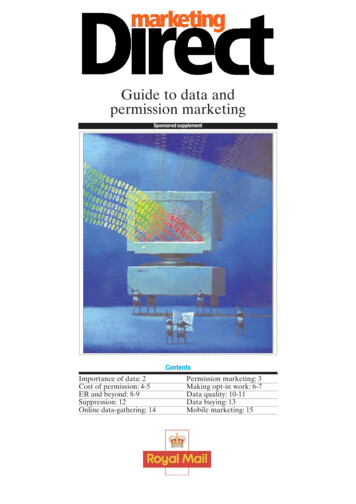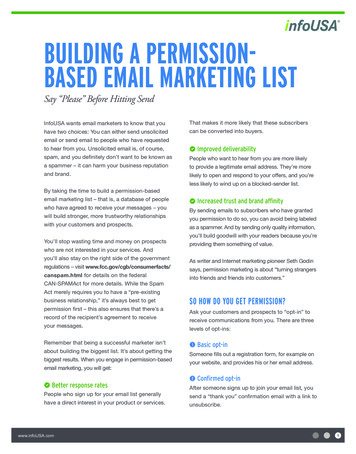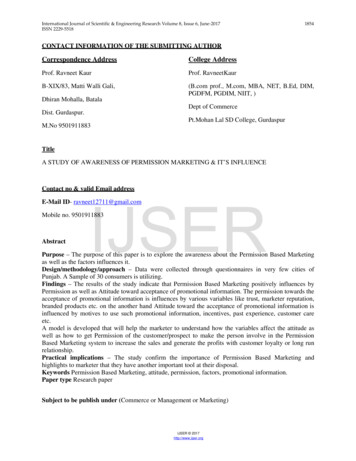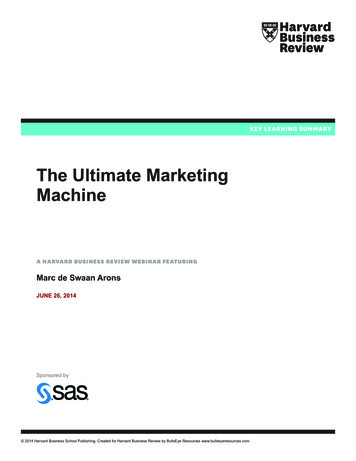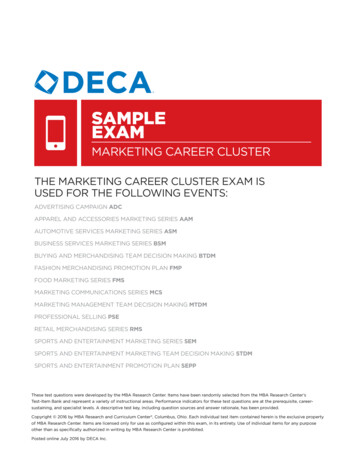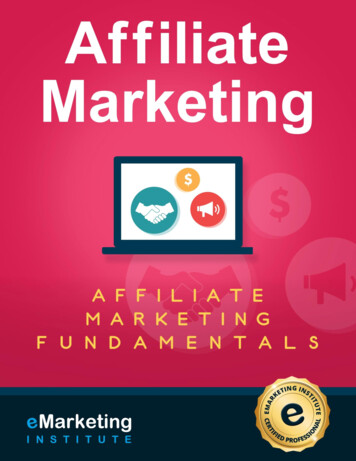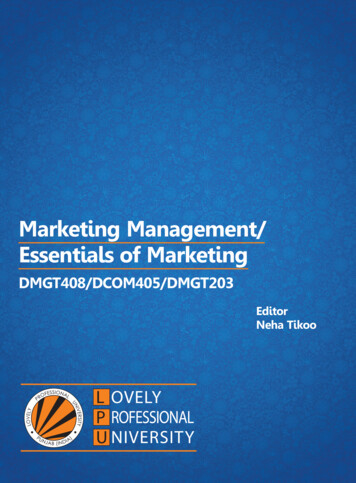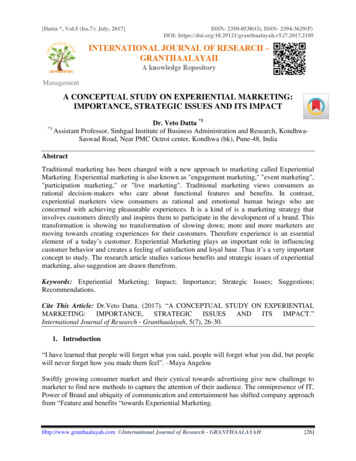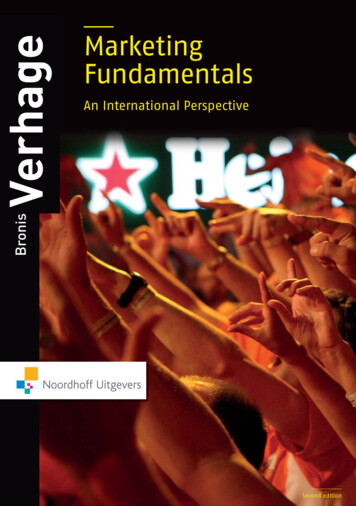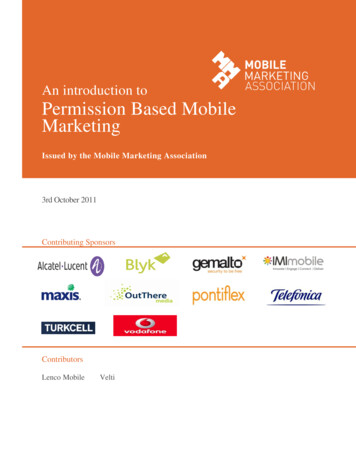
Transcription
An introduction toPermission Based MobileMarketingIssued by the Mobile Marketing Association3rd October 2011Contributing SponsorsContributorsLenco MobileVelti
The practice of gaining consent fromconsumers in advance of a continuingmarketing dialogue taking place onmobile devices and in return for somekind of value exchange.Page 1
TABLE OF CONTENTSI. IntroductionII. Permission Based Mobile Marketing Engagement and TrustIII. First PrinciplesIV. Success StoriesV. Measuring the MediumVI. Key Challenges and ConcernsPublished by Mobile Marketing Association www.mmaglobal.comLondon New York Sao Paolo SingaporePage 2
I. INTRODUCTIONThis paper sets out the case for permission based mobile marketing by defining what it is, how itworks and the benefits to consumers, brands, agencies and mobile network operators. The paperillustrates all of the above through case studies from all over the world, supplied by members ofan MMA Task Force.The MMA believes that permission based mobile marketing should be seen as a separate anddistinct part of mobile marketing. It occupies a unique position, in that it secures and maintainsthe explicit agreement of the consumer to receive communication from and engage in dialoguewith the brand.Permission marketing aims to change the advertising paradigm from interruption tocommunication. It enables brands to move from a broadcast monologue to a dialogue that offersto continue a deepening engagement with loyal customers. The advent of mobile as the channelof choice for many consumers has allowed marketers to take permission marketing to a newlevel. The mobile channel is the best medium for permission marketing because it allows brandsto finally fulfill CRM's promise of one-to-one marketing; dealing with each person as anindividual. Mobile devices create an individual media channel through which consumers can pullpersonalized, desired content and services.At the heart of successful and effective permission based mobile marketing lies the concept of avalue exchange: Consumers exchange their consent, and sometimes personal demographic andpreference information, in advance, for a product, service or offer that they deem of interest, ofrelevance or of worth to them.When consumers give permission for brands and companies to interact with them, they expectthe agreement to be kept: In return for sharing their contact information and personalpreferences, companies must respect their privacy and offer true value. That value may betangible and provide some commercial value, such as coupons, discounts or samples; or it mayprovide entertainment, or information, such as apps or content.Executed correctly, permission based mobile marketing will enable brands to create more longlasting relationships with consumers and help achieve compelling consumer engagement, higherresponse rates and superior returns on investment.Page 3
THE MOBILE OPPORTUNITYThere is a global shift towards communications between brands and consumers taking place inthe mobile channel. Already, in many parts of the world, mobile devices are the primary accesspoint to information and entertainment. As consumer demand for real-time, anywhereinformation and entertainment via mobile devices soared in the past two years, the mobilemedium has become a vital communication channel. It seems clear that consumers are eager touse their mobile phones to keep connected with the brands they love and to receivecommunications that enhance their lifestyles.The growing body of evidence for the progress of the mobile channel points to the fact thatmobile will become an indispensable part of the marketing mix.Strategy Analytics estimates the number of users accessing the mobile web on their handsets willexceed 1 billion by 2015.1 IDC has an even more aggressive position, forecasting that mobileweb users will exceed 1 billion by 2013.2Mobile advertising is growing, as well. Gartner forecasts worldwide mobile advertising revenuewill reach 3.3 billion in 2011, more than double the 1.6 billion generated in 2010.3Consumers are not only viewing ads, they are shopping and completing transactions on theirmobiles. Yankee Group predicts that global mobile transactions will amount to 241 billion in2011, growing to more than 1 trillion by 2015.4To date, much of permission based mobile marketing is delivered through the messagingchannel. As smartphones become the predominant mobile device, the transition towards usingapps, the mobile web and other mobile functionality will allow for rich media and increasedinteractivity.Even at this early stage, in developed markets in Europe and the United States, as well as inemerging markets throughout the Middle East, Africa and the Far East, consumers haveindicated their willingness to enter into some kind of value exchange with mobile networkoperators and brands whether by opting in to receive marketing communications or by agreeingto receive MNO updates.1 "Global Active Mobile Broadband Subscribers Forecast: 2008 – 2014," Strategy Analytics, 7 January ?mod reportabstractviewer&a0 52362 "Worldwide New Media Market Model," IDC, 9 December 2009, ainerId prUS221105093 "Gartner Says Worldwide Mobile Advertising Revenue Forecast to Reach 3.3 Billion in 2011," Gartner Research, 15 June 2011,http://www.gartner.com/it/page.jsp?id 17266144 "Yankee Group Sees Global Mobile Transactions Exceeding 1 Trillion by 2015," Yankee Group, 29 June 2011,http://yankeegroup.com/about us/press releases/2011-06-29.htmlPage 4
For example, in Brazil, a mobile network operatorgarnered a 17% click-through rate for its opt-in offer,powered by Gemalto, that read, "Don‟t miss out! ClickOK and receive exclusive promotions and informationthat XXXXX and its partners prepared for you!"The expansion of mobile media offers advertisersincreasing reach, and the addition of consumerpermission will provide increasing effectiveness. Thesefactors will continue to fuel the development ofpermission based marketing in the mobile sector.Finally, it‟s worth considering that mobile is not reallyjust one channel but multiple ones and permission basedmobile marketing has the potential to use almost anymobile format: Messaging Channels: SMS, MMS, email, USSD Browsing Channel: mobile web Apps Channel: downloadable applications and widgets Download Channel: Mobile Apps (various OS) Proximity Channels: Bluetooth, Wi-Fi, RFID, NFC, LBS proprietary channels Content Channels: streaming/hosted video, audio, gamesPage 5
II. PERMISSION BASED MOBILE MARKETING ENGAGEMENT AND TRUSTIn essence, permission marketing is simply the practice of obtaining permission from a consumerin advance of sending marketing communications. Permission marketing has been a cornerstoneof brand advertising via email since the early 1990s.Former Yahoo marketer and author Seth Godin, who coined the term in his first book, writes,“Permission marketing is the privilege (not the right) of delivering anticipated, personaland relevant messages to people who actually want to get them.It recognizes the new power of the best consumers to ignore marketing. It realizes thattreating people with respect is the best way to earn their attention.Pay attention is a key phrase here, because permission marketers understand that whensomeone chooses to pay attention they are actually paying you with something precious.And there's no way they can get their attention back if they change their mind. Attentionbecomes an important asset, something to be valued, not wasted.”5Permission based mobile marketing allows consumers to overtly identify the brandedcommunications they consider valuable. Its ultimate objective is to build a one-to-onerelationship, via continuing engagement, on a mobile device.The MMA, therefore, defines Permission Based Mobile Marketing as:„The practice of gaining consent from consumers in advance of a continuing marketing dialoguetaking place on mobile devices and in return for some kind of value exchange."THE VALUE EXCHANGETargeted, interactive advertising increases the response rate by presenting consumers withcommunications they're more likely to be interested in. Permission marketing takes this a stepfurther by inviting them to give explicit permission for future engagement in exchange for somepre-agreed benefit or value. Consumers have demonstrated that they're very willing to sharepersonal information if this is the case.Value is subjective, of course, and understanding what it is that your customers value, and thencommunicating clearly to them how your product or service matches that value, are cornerstonesof permission marketing in any channel, including mobile.5 "Permission Marketing," Seth Godin, 31 January 2008, http://sethgodin.typepad.com/seths blog/2008/01/permission-mark.htmlPage 6
VALUE TO CONSUMERSAs has already been noted, the increased desire of consumers to control the frequency and timingof marketing messages and their data being held by a third party means that permissionmarketing as a whole is becoming more attractive to consumers – even if they wouldn‟t use theterm themselves to describe it.Permission based mobile marketing relies on using the most personal medium available and,therefore, allows consumers a greater degree of control over marketing messaging than everbefore.The benefits to consumers of permission based mobile marketing include: A more personalized experience based on the fact that communications are sent to themas an individual and (should be) based on their expressed preferences. As a two-way channel, mobile offers the opportunity to engage in dialogue with a brandof their choice and at a time and in a format of their choosing. Many consumers desire a deeper connection with brands with which they feel aconnection. The information shared with a brand should ensure that communications are morerelevant. In many instances, consumers are able to choose an appropriate time for them to receivemessages from brands of their choice, meaning an end to interruption. Reduced advertising clutter The potential content of the brand messages and dialogue is of inherent value andmay includeoGames and contestsoAlerts on sales or special dealsoPreferred customer discountsoAccess to exclusive, branded contentoMNO incentives such as voice, text or data upgradesResearch from Alcatel-Lucent with 2,223 mobile youth in 11 countries showed that 63% saidthey would have an increased likelihood of purchasing products and services from preferredbrands using a permission based mobile marketing service; 76% indicated that it is important forPage 7
mobile ads to be based on their interests and preferences; 81% considered it very/extremelyimportant to ask permission before sending ad messages on mobiles. 66"Alcatel-Lucent Market Advantage Research, October 2009," Alcatel-Lucent, November ol-ORANGE-learning.htmPage 8
KEY BENEFITS FOR BRANDS AND AGENCIESINCREASED EFFECTIVENESSFirst and foremost, permission based mobile marketing offers the potential to reduce waste inadvertising spending by focusing on the consumers who are most interested in the advertiser‟sproducts or services. It builds on the advantages that mobile brings as a channel to the marketingmix as a whole, in that mobile is the only media channel that combines all of the following: Bridges above and below-the-line communications Takes a consumer from awareness through to conversion via engagement and throughits inherent display, dialogue and payment capabilities Offers contextual relevance and real-time interactionThe medium can improve the return on investment of an advertising budget by increasingresponse and conversion rates. When marketing campaigns are run in accordance with theprinciples of permission based mobile marketing as outlined in this document, there is evidenceto show response and conversion rates tend to be significantly higher than for all other mediachannels. A study of consumers in Asia by Out There Media found that the average conversionrate for opt-in mobile advertising campaigns was 25.15%. Opt-in messaging campaigns alsoreceived more than 20 times the response rate for direct marketing.7In the UK, advertising-supported mobile virtualnetwork operator Blyk achieved an averageresponse rate of 26% for its SMS and MMScampaigns. The Blyk platform partnered withOrange, and the service‟s successor, OrangeShots, now claims response rates of an averageof 25%.87 Permission, Privacy, Measurement: The Way Forward, MMA and Out There Media, May 2011, http://www.out-there-media.com/index.php?id 838 Conversational Advertising, Mobile Squared, June 2010Page 9
In South Africa, credit retailer Mr Price used mobile as a channel tocommunicate personalized financial information to its customers, with acampaign designed and executed by Lenco Mobile. The company found that themobile medium outperformed other more traditional channels such as email andpost, while simultaneously reducing the cost of communication and providinghigher returns on advertising spend. 99 MMA Global Mobile Marketing Awards, November 2010Page 10
IMPROVED TARGETINGTraditionally marketers segment their customer base through demographics like age and gender.Through building an opted-in base of consumers with profiles, brands will be able to tailor theirmessages based on consumers' stated interests and/or ongoing behavior. Over time, this becomesa much richer way of segmenting customer bases, offering even more value to consumers andproducing a better return on investment.Brands and agencies report these additional potential benefits: The mobile medium encourages quick response; 90% of SMS messages are read withinthree minutes of receipt.10 Ability to provide targeted and contextually relevant messages Ability to fine-tune campaigns in close to real time Creation of long-term client relationships instead of single campaigns Entry into interactive dialogue instead of one-way communication Ability to remarket or retarget Creation of communities and fan groups Improved tracking and accountabilityVodacom, a subsidiary of the Vodafone Group, used anintegrated media campaign to drive traffic to its upgrade mobisite in order to notify subscribers about their eligibility for anupgrade. The site experienced significant and sustainabletraffic with an exceptional return on investment. Over a singlemonth, the call to action, delivered via an MMS message, ledto a 600% uptake.1110 Ibid.11 "VCUpgrade.mobi - Vodacom South Africa's Mobile Upgrade Portal," Vodacom, utions See also www.vcupgrade.mobiPage 11
KEY BENEFITS FOR MOBILE NETWORK OPERATORS (MNOs)MNOs, of course, already haveexisting relationships with millionsof consumers, storing theirinformation in databases which, inmany cases, require user consent.Their direct billing relationshipoffers them the opportunity tocollect more data on individuals inorder to enhance their preferenceprofiles.MNOs have the opportunity to gain on two broad counts through permission based mobilemarketing: They can increase customer satisfaction and also open up new revenue streams bypartnering with content creators and advertisers.Mobile network operators, therefore, find potential value in permission based mobile marketingthrough: Improved brand image and subscriber loyalty: Orange (UK) found that Bright Stuff, itspermission based messaging service, increased satisfaction among 35% of itscustomers.12 Additionally, a study by Alcatel-Lucent indicated that 48% of mobile youthwould remain loyal to their operator if offered access to permission based mobilemarketing.13 A reduction in churn and potential to migrate subscribers to higher-value services The creation of new service offerings for specific subscriber segments Increased insight into subscribers and their preferences Increased ARPU: revenue from the advertising spend can outweigh the cost to deliver themedia Acting as the mechanism for connecting consumers to valued brands Increase in paid-for, on-net, data network usage from subscribers and advertisers ratherthan losing revenue to over-the-top players12 "Never mind protecting, what about enhancing operators’ subscriber investments?"Blyk Media, 14 December cting/13 Alcatel-LucentPage 12
III. FIRST PRINCIPLESPermission based mobile marketing can be seen as a four-stage process:STEP 1. GAINING CONSENTFollowing the principles of permission marketing for gaining consumer consent will enhancevalue for consumers and effectiveness for advertisers. The benefits include:Choice. Building trust and engagement through permission based mobile marketing begins withoffering the consumer a clear choice to opt in. It should be very clear to consumers why they arebeing asked to opt in and what giving permission means. (In the United States, the MMAConsumer Best Practices Guide prescribes a double opt-in system, wherein consumers give theirinitial consent only to a specific program. They should be asked again for permission before theyare enrolled into subsequent messaging programs.)14Value. At this initial stage, the value of what they will receive should be communicated clearly,such as the opportunity to connect with their favorite brands, get timely information, savemoney, etc.Transparency. The owner of the opt-in database (this could be an MNO or an advertiser)should state clearly how it intends to use the consumer's data and provide a link to a clear andsimple privacy policy during the opt-in process.Ease. Make the act of giving permission as easy as possible. The initial opt-in request may bemade via any channel, including fixed web, SMS, Interactive-SMS, MMS or email. Whenfeasible, allow opting in within content or applications, instead of sending consumers to a mobileweb site. Research has shown that increasing the amount of personal information asked for upfront decreases the number of opt ins. Alcatel-Lucent research shows that 71% of consumerswould be willing to answer at least four questions to help determine their preferences forpersonally- relevant ads.1514"U.S. Consumer Best Practices," MMA, March 1 2011, www.mmaglobal.com/bestpractices.pdf15 Alcatel-LucentPage 13
Relevance. The perception of value differs among consumers, and relevance is relative. Toincrease the number of opt-ins, use a combination of actual consumer feedback and dataanalytics to tailor different offerings to different segments of customers.Control. Consumers remain in control of their data and should be able to easily changepermission and the information they share. They should be able to access and modify theirpreference profiles, as well as determine the frequency of messaging.Opting Out. Each message should include the ability to opt out via immediate full unsubscribeor to unsubscribe from certain categories of messaging. Consumers should also have the abilityto opt out from where they have access to their profiles, as well as within the messages, etc.STEP 2. CREATING A DATABASE OF PREFERENCE PROFILESCompanies must find a balance between keeping the registration barrier low to encourage opt inand gaining enough information at opt in to create a rich database. The amount of personalinformation collected from consumers at registration should be limited. Over time and with theconsumer's consent, companies can combine this initial information with insight gleaned throughuser behavior to enhance each consumer's preference profile in the database.Categories of data that can be collected include: Basic demographics: gender, age and income or spending habits Interests: content categories such as news, entertainment, travel, dining Attitudes: values, opinions and lifestyle Location: home, workplace and real-time location Behavior: tendency to use coupons, enter contests or engage with contentIn permission based mobile marketing, the user's current location is often a key data point. Itallows for the delivery of contextually targeted messages. Location information can be obtainedthrough the mobile network operator or directly from the mobile phone‟s GPS. Once again,permission must be obtained to activate location-based services.“Contextual relevance allows marketers to deliver a message to mobile consumers based uponwho they are, where they are, what they are doing and when the message is both convenient andvaluable. Location-based services allow brands and mobile network operators to know where anPage 14
individual is and what time of day it is, so they can target messages based on exactly wheresomeone is and the time of day. It should be noted that time and location can also be treatedseparately to deliver contextual relevance. In addition, the mobile device allows a marketer tounderstand the need state of individuals based upon what they are doing on their handsets andany personal preferences the consumer has chosen to share”.16STEP 3. ESTABLISHING MOBILE AS A COMMERCIAL MEDIA CHANNELPreference profiles of opted-in users may be sold as media directly to brands, media agencies orad networks. They may be sold or resold through a variety of entities: Media agencies Media companies MNOs Technology providers Mobile advertising networksPermission based mobile media can be sold using pricing schemes that are already familiar toadvertising and media agencies: cost per mille (CPM) or cost per action (CPA).Cost per mille (CPM): The advertiser pays for every thousand messages or adimpressions delivered, specifying how many impressions should be served.Cost per response/engagement (CPR/CPE): This is also known as pay-forperformance or performance advertising. The advertiser only pays when consumers take adesired action. Pay-per-click or PPC is the most familiar type of performance advertisingbut almost any interaction can be set as the criterion.Cost per acquisition (CPA): The advertiser pays a set fee for each conversion whichmay be defined in a number of ways including making a sale or registering.16"The Future of Mobile Marketing: Contextual Relevance," Paul Berney, http://blog.marketing-soc.org.uk/?s paul berneyPage 15
Advertisers and media companies plan and buy media based on reach and target audience. Thechallenge for providers of opt-in databases is achieving enough volume to provide the reach thatadvertisers demand. The goal for those creating databases of permission based preferenceprofiles will be to: Get permission from as many people as possible in order to achieve reach Gather as much valuable personal and/or preference data as possible on which tobase targetingThe categories of preference and behavioral data that will provide the most effective permissionmarketing database depend on the requirements of the company. Profiles must be rich enough todetermine message relevance without being so restrictive that sufficient audience volume can't beobtained. Third-party providers of databases of opted-in consumer preference profiles shouldwork with brands, agencies and mobile marketing companies to determine the best mix ofdemographic, psychographic and behavior data points to meet brands' objectives.For example, MTV in the United States sends several million SMS messages per month to itsopt-in database, and it aims to expand this activity to levels approaching 30 to 40 million textsper month to create sufficient inventory to attract advertisers. The response rate ranges from highsingle digits to around 50%, with a median response rate of 16%.17Because of the greater accuracy of targeting, increased relevance to consumers and higher returnon investment of this medium, the price of inventory tends to be higher. Sellers in thismarketplace should provide case studies to prove the worth of permission based mobile mediaand identify its role in the marketing mix.STEP 4. ONGOING ENHANCEMENT OF PREFERENCE PROFILESTo achieve the greatest relevance for consumers while providing the best response for brands andadvertisers, it's essential to continue to build and modify each preference profile. To maintain ahigh-quality database of engaged consumers that can be used for successful permission basedmobile marketing, it's important to check, maintain and, if necessary, reestablish value withconsenting consumers on an ongoing basis.The database manager can build the profiles by adding information gleaned from eachconsumer's actions and responses, or lack thereof. The data could also be enhanced with17 Conversational Advertising, Mobile Squared, June 2010Page 16
information from other sources but any usage of additional information has to be counterchecked with the respective legal environment!Once a relationship is established, brands can invite the consumer to help fine-tune hispreference profile. This can be accomplished directly by giving him access to the profile, alongwith a menu of items to check off, or he can be presented with subsequent offers that include therequest for more information.Analytics applications and services can deepen the preference profile by examining eachconsumer's propensities to engage with different kinds of mobile media. For example, oneindividual may be very responsive to contests, while another often clicks on links to streamingvideo. Behavioral analytics can then be used to tailor messages and media to different segments.Each consumer‟s response during the conversation with the brand will provide the latest andmost up-to-date preference information.MAINTAINING CONSENTAs noted, consumers should have control of when and how they receive marketing messagingand must be allowed to easily terminate or opt out of an unwanted program or individualcampaign. Therefore, the maintenance of permission is hugely important to the ongoing qualityof the database preference profile and consequently the success of the proposition.Response and conversion rates tend to be significantly higher than for all other media channelswhen principles are followed. These are best principles for maintaining consent:Continuing communication of value: Sponsored content or services should come with areminder that they are free to the consumer because of the sponsor. Messages such as, "Exclusiveto mobile club members," or, "You just won 500 free minutes!" remind consumers of why theyhave given their permission.Careful targeting to preferences: Understanding a consumer‟s interests or preferences andonly communicating about them has been a key element in the success of permission basedmobile marketing.Privacy: Respecting consumer privacy by not passing the data to any third parties is crucial andshould be explicitly and continually explained to consumers.Page 17
IV. SUCCESS STORIESPermission based mobile marketing is applicable to all industry verticals. The industry types thathave been the most active are: Fast-moving consumer goods Fashion and beauty Financial services Automotive Consumer electronics Entertainment Sports Travel and tourismPermission based mobile marketing is a burgeoning segment, with new and exciting campaignslaunching all the time. There already is a substantial body of case studies showing theeffectiveness and reach of this medium. Let's take a look at a few campaigns that illustrate thepotential for engaging consumers and calling them to action.FAST-MOVING CONSUMER GOODSDynamo, a maker of laundry detergent, wanted to encourage Malays to trade up from the powderto the liquid version. It used the permission marketing base of network operator Maxis, built byOut There Media, for a campaign with two goals: awareness of the liquid product and trial. Theseven-day campaign targeted women 20 to 49 years old with SMS and MMS messages.First, message recipients were asked whether they used liquid or powder detergent, for a chanceto win a washing machine. Those who already used liquid were directed to a WAP site wherethey could register for the contest. Those who used powder received a mobile coupon for adiscount on a bottle of liquid soap.Page 18
The campaign successfully reached 135,628 women, with a response rate of 6.8%. Click-throughto the WAP site was 17.6%. The average number of page views per visit was 2.21, registrationrate was 15%, and 209 consumers downloaded a coupon, for a total downloads rate of 42%.FASHION AND BEAUTYUnilever wanted to create awareness of its new Best-Ever Sunsilk Co-Creations line of hair careproducts to women aged 18 to 35, as well as to drive traffic and likes on its Sunsilk Hair ExpertsFacebook page.Out There Media engaged the target audience with an SMS dialog, pointing them to both thecampaign‟s Facebook Page and a mobile site where more information could be obtained.Consumers could participate in a contest and win weekly prizes by liking the brand‟s Facebookpage and voting for their favorite Sunsilk Expert Makeover finalists. A web banner campaignalso created awareness and directed consumers to Facebook.Among the message recipients, 24.7% responded to the initial message, and 3.1% clickedthrough to the WAP site. This CTR rate is much lower than the benchmark for similarcampaigns, because Unilever's primary goal was sending consumers to Facebook as the next linkin the engagement train. The advertisers saw a spike in Facebook activity and contestparticipation during the message broadcast period.AUTOMOTIVEIn Ghana, car dealers bring in a shipload of vehicles, sell them, and only then order anothershipload. The sooner word gets out, the faster the dealer can complete transactions. UniversalMotors, the exclusive dealer for Volkswagen, wanted to use direct mobile marketing to alertcustomers to the availability of the new Volkswagen Touareg.Tigo, a mobile network operator in Ghana, used the Optism solution from Alcatel-Lucent to sendinteractive text dialogue ads to the mobile phones of subscri
II. PERMISSION BASED MOBILE MARKETING ENGAGEMENT AND TRUST In essence, permission marketing is simply the practice of obtaining permission from a consumer in advance of sending marketing communications. Permission marketing has been a cornerst


